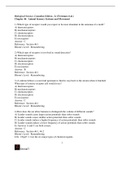NR-577 Primary Care Management Of
Adolescents & Adults Final Exam 2024 Review
Questions with Answers and Rationales | 100%
Pass| Graded A+
David Mungai [Date] [Course title]
, NR-577 Primary Care Management Of
Adolescents & Adults Final Exam 2024
Review Questions with Answers and
Rationales | 100% Pass| Graded A+
142. A mother brings in her 16-year-old daughter for a wellness
check and has concerns that she has not had her first menstrual
period. After a thorough history and physical exam, the nurse
practitioner notes a sexual maturity rating of 4 for both breast and
pubic hair development. The patient does not have any acne or
hirsutism. What initial tests should be ordered for evaluation of
amenorrhea?
a. CT scan of the head
b. Pelvic ultrasound
c. Urine pregnancy test, TSH, CBC, prolactin, and FSH
d. Serum estradiol, serum Testosterone - Answer>> C.
A pelvic Ultrasound may be ordered if unable to assess whether
or not the uterus is present by bimanual exam, but that would
have been indicated in the questions root. A CT scan would be
prudent after prolactin level was shown to be elevated. If
hyperandrogenism (acne or/or hirsutism) is present a serum
testosterone could be added to initial labs. The initial evaluation
should include urine pregnancy test, TSH, CBS, prolactin, and
FSH.
143. A 15-year-old boy presents to the clinic stating that over the
past 6 months he has had a bilateral increase in breast size.
Palpation of breast tissue shows fibrous mass under nipple-
areolar complex. Patient is not taking any medications; sexual
development is appropriate for age and there are no additional
findings on physical exam. The appropriate next step would be:
,a. Provide reassurance that this typically resolves on its own
within 2 years.
b. Refer to a breast surgeon
c. Refer to an endocrinologist
d. Check TSH, testosterone, estradiol, HCG, and LH -
Answer>> A.
144. A mother brings her 15-year-old daughter in the clinic
because she is concerned her daughter has not started her
menses yet. Upon examination, you note on the breast area the
areola and nipple form a separate mound that is protruding from
the breast. The patient has axillary hair and pubic hair that is
becoming darker in color and is starting to curl. What is the best
response by the APRN?
A. According to your daughter's physical exam, she is in Tanner
stage 3. Normal age for menarche is between 10 to 16 years of
age. She has signs of progressing sexual maturation, so
currently, we do not need to do any further workup.
B. Since the average age of menarche is 12, we will need to order
some lab work (FSH, LH, testosterone/estradiol) and order an
ultrasound to evaluate causes for the delay.
C. Based on the physical exam, your daughter is not showing
signs of sexual maturation, and we need to order an x-ray to dete
- Answer>> A.
145. You are seeing a transgender woman who wants to see you
for a primary care provider. The patient informs you that she is
taking feminizing hormone therapy. As an APRN, you know the
most important thing to keep in mind regarding feminizing
hormone therapy is:
A. Estrogen therapy will only end with a Tanner stage 1-2
B. Progestins have been proven safe with no side effect profile
reported
, C. Injected estradiol is the preferred route for those who smoke or
have risk factors for a VTE
D. Spironolactone, most commonly used anti-androgen, should
include periodic lab work for kidney function and serum potassium
levels - Answer>> D.
146. You are educating an independent 60-year-old African-
American with type 2 diabetes, asthma, and osteoarthritis about
her calcium requirements. Which would you recommend?
a. Take a calcium citrate supplement of 1,200 mg a day.
b. Eat a diet that includes chicken, beef, or pork.
c. Take a calcium carbonate supplement of 1,000 mg a day.
d. Eat a diet that includes yogurt, cheese, tofu, and green leafy
vegetables. - Answer>> D.
Recommended calcium intake for women younger than 50 years
is 1000 mg/day and for women aged 51 and over, it is 1200
mg/day. Dietary calcium is the preferred route for calcium intake
because calcium supplements have been associated with an
increased risk of myocardial infarction. Meats are not considered
a source of dietary calcium. Calcium supplements, if they are
taken, can be given as either calcium citrate or calcium carbonate
and should be combined with vitamin D.
147. A diagnostic mammography is indicated as first-line
evaluation for which woman?
a. A 29-year-old Hispanic woman with a painless 3 cm nodule in
her left breast at 3 o'clock.
b. A 38-year-old white woman with bilateral diffusely painful
breasts that occur 2 days before her menses and then resolve.
c. A 46-year-old African American woman with cystic breasts and
a new painless lump in her right breast at 11 o'clock.
d. A 35-year-old Japanese woman with a positive history for first
degree relative with breast cancer. - Answer>> C.





